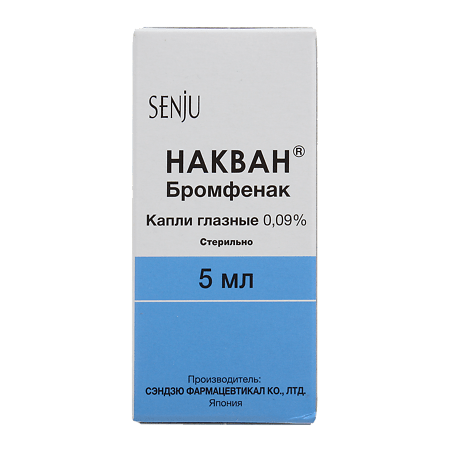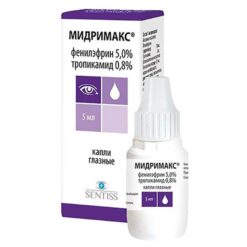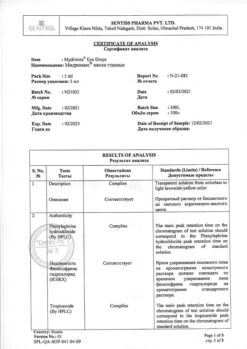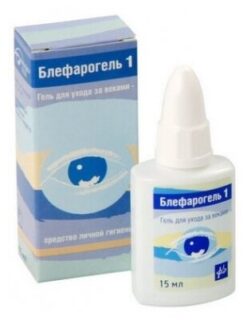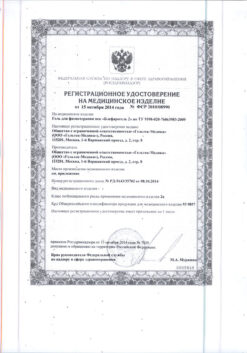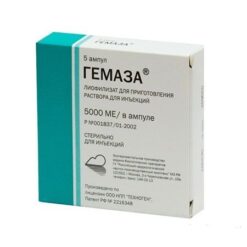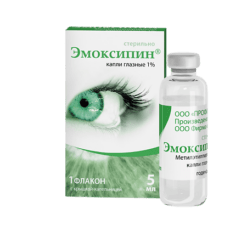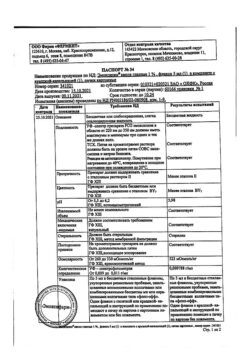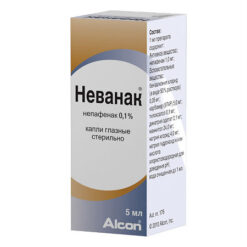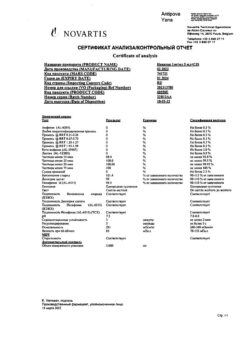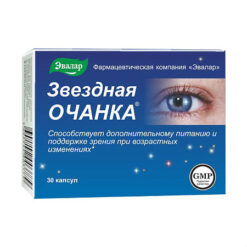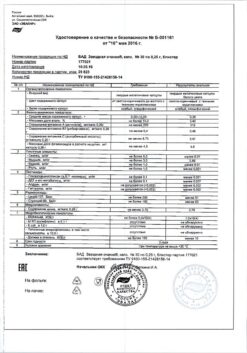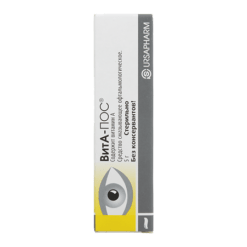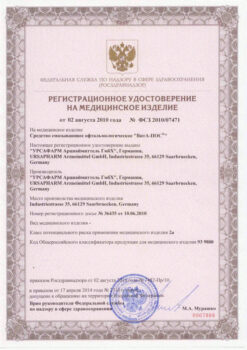No products in the cart.
Naquan, eye drops 0.09% 5 ml
€17.78 €14.82
Out of stock
(E-mail when Stock is available)
Description
Bromfenac is a non-steroidal anti-inflammatory drug (NSAID) whose anti-inflammatory effect is realized by blocking prostaglandin synthesis by inhibiting cyclooxygenase 1 and 2.
In in vitro studies, bromfenac inhibited prostaglandin synthesis in the ciliary body of rabbits. The concentration of half-maximal inhibition (IC50) for bromfenac (1.1 μmol) was lower than for indomethacin (4.2 μmol) and pranoprofen (11.9 μmol).
Indications
Indications
Treatment of non-infectious inflammatory diseases of the anterior segment of the eye and postoperative inflammation.
Pharmacological effect
Pharmacological effect
Bromfenac is a non-steroidal anti-inflammatory drug (NSAID), the anti-inflammatory effect of which is realized by blocking the synthesis of prostaglandins by inhibiting cyclooxygenase 1 and 2.
In in vitro studies, bromfenac inhibited prostaglandin synthesis in the rabbit ciliary body. The half-maximal inhibition concentration (IC50) for bromfenac (1.1 µmol) was lower than for indomethacin (4.2 µmol) and pranoprofen (11.9 µmol).
Special instructions
Special instructions
This drug should be used as part of symptomatic treatment, and not for the purpose of etiotropic therapy.
This medication should only be used as eye drops.
Active ingredient
Active ingredient
Bromfenac
Composition
Composition
1 ml of solution contains:
Pregnancy
Pregnancy
There are no sufficient data on the use of bromfenac in pregnant women. Animal studies have demonstrated reproductive toxicity. The potential risk to humans is unknown. Since systemic exposure following drug treatment in non-pregnant women is negligible, the risk during pregnancy can be considered low.
However, due to the known effects of drugs that inhibit prostaglandin biosynthesis on the fetal cardiovascular system (ductal closure), use of this drug should be avoided during the third trimester of pregnancy. In general, the use of this drug during pregnancy is not recommended unless the benefits outweigh the potential risks.
Contraindications
Contraindications
This drug is contraindicated in patients with a history of hypersensitivity to any component of the drug.
This drug is contraindicated in patients whose attacks of bronchial asthma, urticaria and symptoms of acute rhinitis are aggravated by taking acetylsalicylic acid and other NSAIDs.
Age up to 18 years (the safety and effectiveness of the drug in children have not been studied).
Side Effects
Side Effects
Adverse reactions to the drug were observed in 72 of 3843 patients (1.87%), data on which were obtained as part of clinical trials or during post-registration use. Serious adverse reactions included corneal erosion in 16 cases (0.42%), conjunctivitis (including conjunctival injection and conjunctival follicles) in 11 cases (0.29%), blepharitis in 9 cases (0.23%), irritation in 8 cases (0.21%), ocular pain [transient] in 8 cases (0.21%), superficial punctate keratitis in 6 cases (0.16%), itching in 6 cases (0.16%), corneal epithelial detachment in 1 case (0.03%) and burning sensation [of the eyelids] in 1 case (0.03%).
Adverse reactions are classified according to the following gradation of frequency of occurrence:
Very common >1/10
Often ≥1/100 to <1/10
Rarely from ≥1/10000 to <1/100
Very rare <1/10000
In each group, adverse events were classified according to decreasing severity and grouped according to frequency of occurrence and organ system class.
The table below describes adverse reactions.
Frequency of occurrence
Adverse reaction
Visual disorders
Uncommon
Corneal erosion (*), conjunctivitis (*), blepharitis (*), irritation (*), eye pain [transient](*), superficial punctate keratitis (*), itching (*)
Rarely
Detachment of the corneal epithelium (*), burning sensation [eyelids](*)
Unknown
Corneal ulcer (**)(***), corneal perforation (**)(***)
Hypersensitivity
Unknown
Contact dermatitis (*)
(*) If adverse reactions occur, you must stop treatment with the drug.
(**) If clinically significant adverse reactions occur, such as the development of diseases of the corneal epithelium, etc., it is necessary to stop treatment with this drug and take appropriate measures.
(***) Serious adverse reaction, isolated reports from experience with post-registration use of the drug.
Interaction
Interaction
No interaction studies have been conducted with other drugs.
Overdose
Overdose
At the moment, there is no information on overdose with topical use in humans.
According to foreign reports, patients who took oral bromfenac sodium at a total dose exceeding 1500 mg for an extended period of time greater than 1 month experienced serious liver dysfunction (including deaths). In this regard, if abnormalities are detected that are presumably associated with early symptoms of liver failure, it is necessary to stop treatment with this drug and take appropriate measures.
Storage conditions
Storage conditions
Store at a temperature not exceeding 25 °C. Keep out of the reach of children.
Shelf life
Shelf life
2 years. Do not use after the expiration date stated on the package. After the first opening of the bottle, it should be stored for no more than 30 days.
Manufacturer
Manufacturer
Senju Pharmaceutical, Japan
Additional information
| Shelf life | 2 years. Do not use after the expiration date stated on the package. After the first opening of the bottle, store for no more than 30 days. |
|---|---|
| Conditions of storage | Store at the temperature not more than 25 °С. Keep out of reach of children. |
| Manufacturer | Senju Pharmaceutical, Japan |
| Medication form | eye drops |
| Brand | Senju Pharmaceutical |
Related products
Buy Naquan, eye drops 0.09% 5 ml with delivery to USA, UK, Europe and over 120 other countries.

